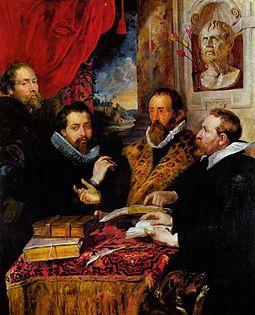|
Repoussoir
In two-dimensional works of art, such as painting, printmaking, photography or bas-relief, repoussoir (French: [ʁəpuswaʁ], pushing back) is an object along the right or left foreground that directs the viewer's eye into the composition by bracketing (framing) the edge. It became popular with Mannerist and Baroque artists, and is found frequently in Dutch seventeenth-century landscape paintings. Jacob van Ruisdael, for example, often included a tree along one side to enclose the scene (see illustration). Figures are also commonly employed as repoussoir devices by artists such as Paolo Veronese, Peter Paul Rubens and Impressionists such as Gustave Caillebotte.[1]
References
Look up repoussoir in Wiktionary, the free dictionary.
|



![Georges Seurat, Gray Weather, Grande Jatte (1888, 71 × 66 cm, oil on canvas, Metropolitan Museum of Art). In a similar manner to the van Ruisdael piece, the tree that takes up the entire right edge of this work is an example of repoussoir.[2]](http://upload.wikimedia.org/wikipedia/commons/thumb/5/59/Gray_Weather%2C_Grand_Jatte_%281888%29_-_Georges_Seurat_%28Metropolitan_Museum_of_Art%29.jpg/384px-Gray_Weather%2C_Grand_Jatte_%281888%29_-_Georges_Seurat_%28Metropolitan_Museum_of_Art%29.jpg)